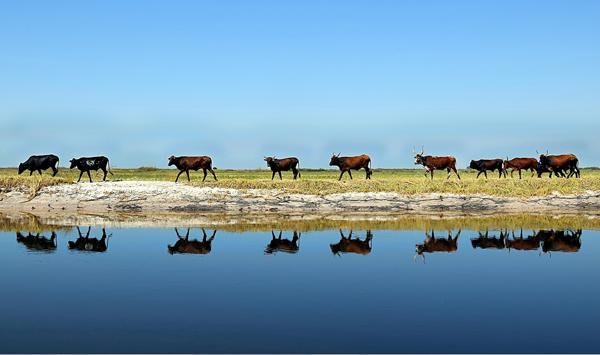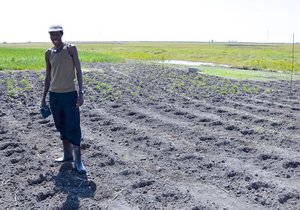Blog Farming systems and how they relate to local diets in the Barotse

What do communities in the Barotse floodplain in Zambia grow and why? What are their constraints to using crop biodiversity? Read more about this transient floodplain in this guest blog post from Wageningen University.
By Trinidad del Río, Wageningen University
When people in the Barotse flood plain are asked what their favourite food is and why, almost all of them answer ‘nshima’ (white cornmeal) because it makes them feel satisfied. Diets in this area of Zambia are generally very low in diversity and dominated by staples, as observed in many rural areas in East and Southern Africa. In the Barotse, diets show a high dependency on local production and fishing. Despite the biodiversity and agricultural potential of the area, the food variety on farms, markets, and on their plates is low. To understand current patterns and identify entry points for diversifying production and consumption, we studied the farming systems and practices of three communities in the Barotse floodplain landscape (Mapungu, Lealui and Nalitoya).
 Farmers classify different land types in terms of specific soil properties, flooding or drought risks, and degrees of remoteness. On average, farmers have seven plots or fields, which are located on different land types. More fertile soils are usually located lower and closer to the river, and so are more prone to unpredictable flooding (Photos A and B). Limited accessibility, either because of flooding during the wet season (Photo C), or distances of up to 7 km from farmer’s homes to their plots (Photo D), are considered important constraints for agricultural diversification.
Farmers classify different land types in terms of specific soil properties, flooding or drought risks, and degrees of remoteness. On average, farmers have seven plots or fields, which are located on different land types. More fertile soils are usually located lower and closer to the river, and so are more prone to unpredictable flooding (Photos A and B). Limited accessibility, either because of flooding during the wet season (Photo C), or distances of up to 7 km from farmer’s homes to their plots (Photo D), are considered important constraints for agricultural diversification.
Although the three communities share a common area and culture, each of them has particular landforms that affect their livelihoods. It depends on whether they are located in the heart of the floodplain (Lealui), between the plain and the ‘saana’ (Mapungu) or closer to the uplands (Nalitoya). In the plain, farmers have to deal with salty soil, weeds, floods, pests and other larger crop predators (such as birds and livestock, even hippos!). In the ‘saana’, most plots depend on groundwater levels, which vary considerably throughout the seasons and years. When water in the upland canals can flow freely (not obstructed by vegetation or debris that communities are supposed to clear), the surrounding lands drain faster and can be used for agriculture. However, due to the restricted input of organic matter, soil fertility declines over time, and is sometimes compounded by the burning of weeds. This loss of soil fertility is also occurring in the plain. Soils located further from water sources are very poor (Kalahari sands) and depend on the rains.
In terms of crop diversity, maize and rice are cultivated on almost half of the total measured area. Most of the food that communities produce is for their own consumption, but when yields are higher, they also sell part of it within the village, at a nearby town or in Mongu (the capital of Western province). Farmers commonly sell cabbage, tomato, rice, carrot, pumpkin and eggplant. They recognize crop diversification as a major strategy to help them reduce risks and overcome the hungry season (September-December). However, farmers mentioned limitations to using diversity, such as a lack of seeds adapted to local conditions and their availability (timing is an issue as well), and a need of knowledge about “new” crops, how to use crop residues and soil management. Farmers also mentioned not having enough labour, not timing tasks appropriately (e.g. planting, weeding and harvesting dates) and bare soils being exposed to the first torrential rains of the season.
 Despite these constraints, we found stories of success. One example is Mr. Mumeka Lubinda, who has been practicing conservation agriculture since 2004, and getting higher rice and wheat yields at lower costs and without using pesticides. He also needs less labour compared to his neighbours and in the past. In addition, Mumeka grows a wide variety of other crops, including vegetables and fruits. Encouraging these practices and fostering knowledge exchange between farmers in this community and in others with similar geographical conditions, could stimulate productivity. It is of course important to test and adapt these practices to different circumstances.
Despite these constraints, we found stories of success. One example is Mr. Mumeka Lubinda, who has been practicing conservation agriculture since 2004, and getting higher rice and wheat yields at lower costs and without using pesticides. He also needs less labour compared to his neighbours and in the past. In addition, Mumeka grows a wide variety of other crops, including vegetables and fruits. Encouraging these practices and fostering knowledge exchange between farmers in this community and in others with similar geographical conditions, could stimulate productivity. It is of course important to test and adapt these practices to different circumstances.
Our research in the Barotse places emphasis on the views of community members, using a participatory, bottom-up approach. Some community members who speak English act as facilitators that link the inhabitants of the landscape and external organizations. They could play a crucial role in strengthening practical activities that contribute to improved nutrition. For instance, workshops organized (in their own landscape) on using solar energy to dry and preserve vegetables that they can consume during the hungry season; making compost from human waste to increase soil organic matter; and the implementation of learning plots that are an opportunity for farmers and scientist to learn and share promising crop management strategies, as well as new species and varieties suitable for the Barotse floodplain system. It is important that these activities have some short-term results for communities in order to maintain their enthusiasm to participate in research. Learning by doing, will also help to improve the livelihoods and nutrition of local communities without compromising the health of the floodplain.
See more photos from the Barotse in this Flickr album
This work on nutrition-sensitive landscapes is carried out by Bioversity International in partnership with the Farming Systems Ecology (FSE) group from Wageningen University and the Earth Institute at Columbia University, to characterize the Barotse landscape and its current farming systems. It is part of the CGIAR Research Program on Aquatic Agricultural Systems (AAS) and the CGIAR Research Program on Agriculture for Nutrition and Health (A4NH).
